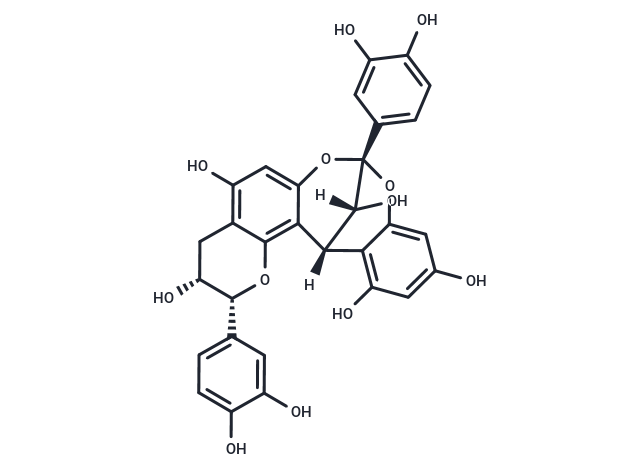Shopping Cart
- Remove All
 Your shopping cart is currently empty
Your shopping cart is currently empty

Procyanidin A2 is a potential precursor of 5-(3',4'-dihydroxyphenyl)-γ-valerolactone, exhibits antioxidant, anti-inflammary, anti-hyperglycemia, and anti-type 2 diabetes activities. Procyanidin A2 demonstrates liver cell regenerative activity in scratch wound healing assays and alcohol-induced liver cell injury in vitro.

| Pack Size | Price | Availability | Quantity |
|---|---|---|---|
| 1 mg | $80 | In Stock | |
| 5 mg | $247 | In Stock | |
| 10 mg | $369 | In Stock | |
| 25 mg | $615 | In Stock | |
| 50 mg | $869 | In Stock | |
| 100 mg | $1,170 | In Stock | |
| 1 mL x 10 mM (in DMSO) | $313 | In Stock |
| Description | Procyanidin A2 is a potential precursor of 5-(3',4'-dihydroxyphenyl)-γ-valerolactone, exhibits antioxidant, anti-inflammary, anti-hyperglycemia, and anti-type 2 diabetes activities. Procyanidin A2 demonstrates liver cell regenerative activity in scratch w |
| In vitro | Here we evaluated Procyanidin A2 as a means of modulating CCL26 production and investigated interactions with the known inflammation modulator, Interferon γ (IFNγ). We used the human lung epithelial cell line A549 and optimized the conditions for inducing CCL26. Cells were exposed to a range of Procyanidin A2 or IFNγ concentrations for varied lengths of time prior to an inflammatory insult of interleukin-4 (IL-4) for 24 h. An enzyme-linked immunosorbent assay was used to measure CCL26 production. Exposing cells to 5 μM Procyanidin A2 (prior to IL-4) reduced CCL26 production by 35% compared with control. Greatest inhibition by Procyanidin A2 was seen with a 2 h exposure prior to IL-4, whereas IFNγ inhibition was greatest at 24 h. Concomitant incubation of Procyanidin A2 and IFNγ did not extend the inhibitory efficacy of Procyanidin A2[1] |
| Molecular Weight | 576.5 |
| Formula | C30H24O12 |
| Cas No. | 41743-41-3 |
| Smiles | [H][C@@]1(O)[C@]2([H])c3c(O)cc(O)cc3O[C@]1(Oc1cc(O)c3C[C@@H](O)[C@H](Oc3c21)c1ccc(O)c(O)c1)c1ccc(O)c(O)c1 |
| Relative Density. | 1.766g/cm3 |
| Storage | store at low temperature | Powder: -20°C for 3 years | In solvent: -80°C for 1 year | Shipping with blue ice. | |||||||||||||||||||||||||||||||||||
| Solubility Information | DMSO: 100 mg/mL (173.46 mM), Sonication is recommended. | |||||||||||||||||||||||||||||||||||
Solution Preparation Table | ||||||||||||||||||||||||||||||||||||
DMSO
| ||||||||||||||||||||||||||||||||||||

Copyright © 2015-2025 TargetMol Chemicals Inc. All Rights Reserved.